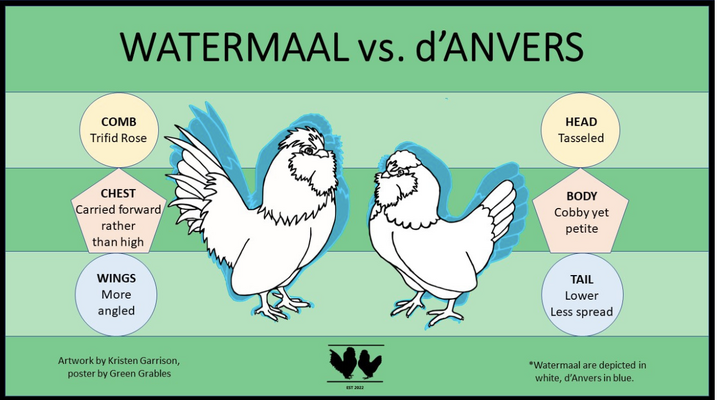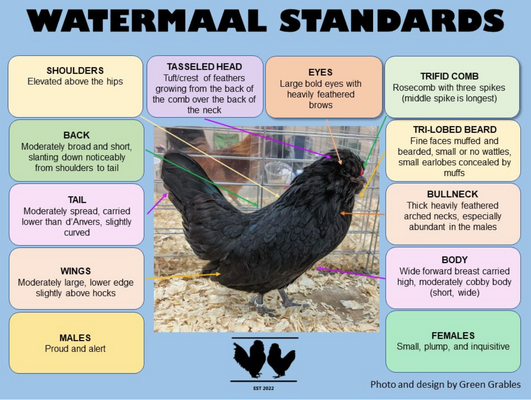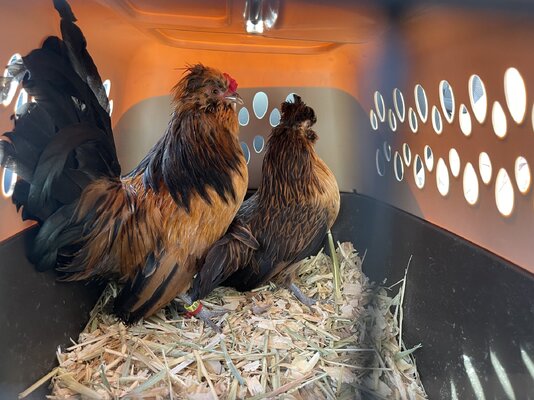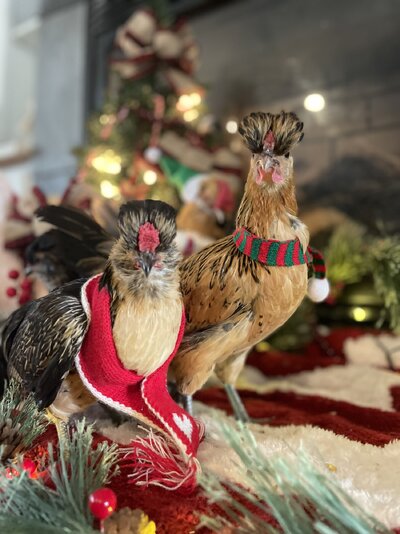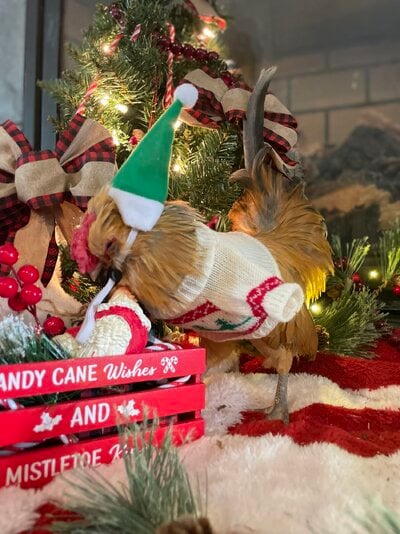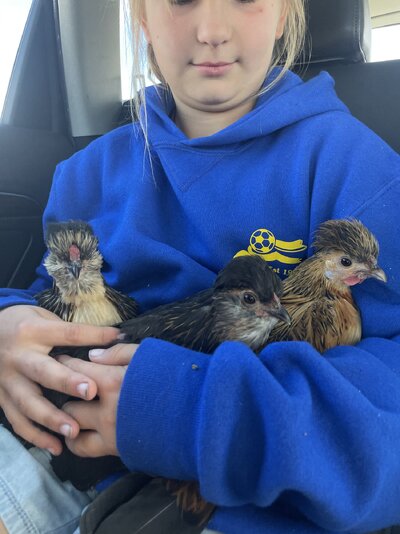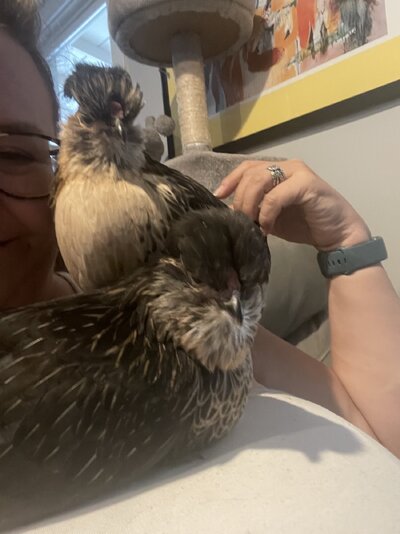The Belgian Watermaal (sometimes spelled as Watermael) is a clean legged true bantam that is ABA recognized and has a dedicated group of breeders and exhibitors working to get it APA recognized. I'll be posting my own flock and welcome anyone else with Watermaal to chime in, this thread is open to anyone who has Watermaal, is interested in learning more about them, or just wants to see cute chickens. The Watermaal Club of America has an active community on Facebook for anyone who is interested. I'm including the current ABA standard as one of the founders of the breed in the US posted here on BYC as well as a few educational posters made by members of the club.
I'll make a post when I get the chance to grab individual pictures of my birds but I currently have 8 birds, 6 white and 2 black, they're about 7 weeks old.
I'll make a post when I get the chance to grab individual pictures of my birds but I currently have 8 birds, 6 white and 2 black, they're about 7 weeks old.
Would like to mention that the Watermaal standard is not published in the ABA because it is listed as an inactive breed. HOWEVER, it IS recognized and it does have a standard here in the United States. The recognized varieties of the breed here are as follows: Black, Blue, Buff, Mottled, Quail and White
Because this is such a rare breed in the US that is not commonly sought out and because there are few people who know a significant amount about this bantam and also because the standard is not actively published in the ABA standard of perfection, I am adding it here so those who are interested can better familairize themselves:
ABA dWatermael Written Standards
Translated from German Standard
Watermaal Bantam
Origin: Belgium. American Status: Rare, if at all.
Note: Should be preserved because of unique three-spiked rose comb.
Weights
Cock: 26 ounces Hen: 22 ounces
Cockerel: 22 ounces Pullet: 20 ounces
Shape of Male
COMB: Rose - broad, rather short, nearly square in front, sitting firmly and evenly on head, top level, covered with fine points, free from hollows, with three spikes that are round at the base to their tips, each tapering to a fine point, the middle spike being longer than the two outer spikes that press down on the tassel.
TASSEL: A tuft or crest of feathers rising from the rear of head at rear of comb, falling gracefully over back neck.
BEAK: Short, strong, well curved.
FACE: Fine in quality, nearly concealed by relatively long muff feathers.
BROW: Heavily feathered.
EYES: Bold, prominent.
WATTLES: Rudimentary only.
EAR LOBES: Very small, inconspicuous, and hidden by muffs.
BEARD & MUFFS: Abundant, very fully developed, the whole forming a collar of three barely separated ovals, giving muffed effect.
HEAD: Appearing to be large because of tassel.
NECK: Medium length, feathers abundant, convexly arched on the order of what is termed bull necked.
HACKLE: Entirely covering shoulders and most of back, forming a closely joined cape in front of neck.
BACK: Moderately broad and short, slanting noticeably from shoulders to tail, rather abrupt angle at juncture with tail.
SADDLE: Profuse, medium length lower saddle feathers.
TAIL: Main Tail - feathers strong, of medium width, moderately spread at all times, carried a little short of the perpendicular, not hidden by sickle feathers.
Sickle -- two main sickles slightly curved, ending in a point at their extremities.
Lesser Sickles -- rising above one another fan-like, ending in point at their extremities.
Coverts -- broad, filling in space between sickles and saddle.
WINGS: Moderately large, carried well back and down below the tail, lower edge slightly above hocks.
Shoulders & Fronts -- well concealed by hackle.
Primaries -- moderately long, concealed by secondaries.
Secondaries -- moderately long and broad.
BREAST: Very broad and deep, upper part well developed and carried well forward.
BODY & STERN: Body -- deep, short, stubby. Stern -- fluff, short.
LEGS & TOES: Legs -- set well apart when viewed from front.
Lower Thighs -- short, stout at top, tapering neatly to hocks, heavily feathered.
Shanks -- medium length, smooth, round, stocky.
Spurs -- short, fine, set low.
Toes -- four, straight, well and evenly spread.
APPEARANCE: Proud, noticeably erect.
Shape of Female
COMB: Rose - broad, rather short, nearly square in front, sitting firmly and evenly on head, top level, covered with fine points, free from hollows, with three spikes that are round at the base to their tips, each tapering to a fine point, the middle spike being longer than the two outer spikes that press down on the tassel.
TASSEL: A small, half globular crest of feathers, rising from rear of head at rear of comb, falling gracefully over back of neck.
BEAK: Short, strong, well curved.
FACE: Fine in quality, concealed muffs.
BROW: Heavily feathered.
EYES: Bold, prominent.
WATTLES: Rudimentary only.
EAR LOBES: Very small, inconspicuous, and hidden by muffs.
BEARD & MUFFS: Abundant, very fully developed, the whole forming a collar of three barely separated ovals, giving muffed effect.
HEAD: Appearing to be rather large due to heavy feathering, reminding one of an owl, carried well back on a parallel line with tip of tail.
NECK: Short, convexly arched, feathers forming a ruffle behind neck, feathers broad and covering shoulders, but not front of neck.
BACK: Moderately broad, short, slanting noticeably from shoulders to tail.
CUSHION: Profuse, feathers broad.
TAIL: Main Tail -- feathers strong, medium width, top feather slightly curved in a convex manner, not too widely spread at a little short of the perpendicular.
Coverts -- abundant, flowing well up tail.
WINGS: Moderately large, carried well up back, lower edges slightly above hocks.
Shoulders & Fronts -- concealed by hackle.
Bows & Coverts -- prominent, well rounded.
Primaries -- medium width, concealed by secondaries.
Secondaries -- medium length, broad.
BREAST: Very broad and deep, upper part well developed and carried well forward.
BODY & STERN: Body -- deep, short, stubby. STERN -- fluff, short.
LEGS & TOES: Legs -- set well apart, straight when viewed from front.
Lower Thighs -- short, stout at top, tapering neatly to hocks, heavily feathered.
Shanks -- medium length, smooth, nicely scaled.
Toes -- four, well and evenly spread.
APPEARANCE: small, plump, sedate.
DISQUALIFICATIONS
Absence of beard or muffs -- Wattles severed or removed -- More or less than three spikes on comb.
DEFECTS
Head carried too far forward -- Comb with concave or hollow center -- Large or conspicuous ear lobes -- Underdeveloped beard or muffs -- Back too nearly level and too long -- Excessive flow of sickles in males -- Excessive length of legs.

